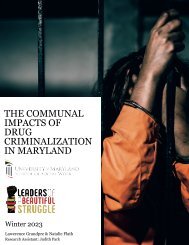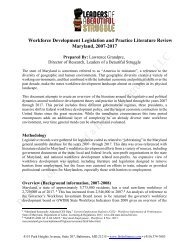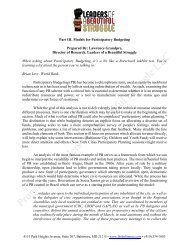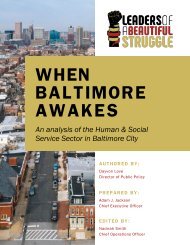Drug Decriminalization in Maryland Through an African Centered Research Paradigm- Analysis and Recommendations
This document offers guidance for theorizing questions related to a proposed research project purposed to advance drug decriminalization in Maryland.
This document offers guidance for theorizing questions related to a proposed research project purposed to advance drug decriminalization in Maryland.
- No tags were found...
You also want an ePaper? Increase the reach of your titles
YUMPU automatically turns print PDFs into web optimized ePapers that Google loves.
<strong>in</strong>tersections of class- <strong>an</strong>d race-based disadv<strong>an</strong>tage (Pruitt 2015). White drug users who<br />
are disparaged appear l<strong>in</strong>ked primarily to rural poverty. Abuse of prescription opioids first<br />
surfaced <strong>in</strong> rural Ma<strong>in</strong>e, <strong>Maryl<strong>an</strong>d</strong>, <strong>an</strong>d then Appalachia among the rural poor, likely<br />
because the isolation made prescription opioids more accessible th<strong>an</strong> street drugs <strong>an</strong>d<br />
because of a high prevalence of pa<strong>in</strong> syndromes related, <strong>in</strong> part, to “hard lives of m<strong>an</strong>ual<br />
labor” (Inciardi <strong>an</strong>d Cicero 2009: 106; Tunnell 2004). Known as “hillbilly hero<strong>in</strong>,” the<br />
use of oxycont<strong>in</strong> <strong>in</strong> rural Appalachia was l<strong>in</strong>ked with crime by local law enforcement <strong>an</strong>d<br />
politici<strong>an</strong>s despite the fact that crime rates did not <strong>in</strong>crease (Tunnell 2004, 2005). Several<br />
studies of methamphetam<strong>in</strong>e have rooted the construction of that drug as white <strong>in</strong> the<br />
grow<strong>in</strong>g economic <strong>an</strong>d class <strong>in</strong>securities of rural whites. Garriott (2011, 2013) argues that<br />
meth production <strong>an</strong>d use grew <strong>in</strong> rural communities for a number of reasons, <strong>in</strong>clud<strong>in</strong>g the<br />
need to supplement <strong>in</strong>come <strong>in</strong> areas where jobs are scarce <strong>an</strong>d low wage <strong>an</strong>d to help<br />
workers <strong>in</strong> monotonous, repetitive jobs (like the poultry <strong>in</strong>dustry) perform better. Even<br />
with<strong>in</strong> class, there are import<strong>an</strong>t dist<strong>in</strong>ctions to be made between rural, suburb<strong>an</strong>, <strong>an</strong>d<br />
urb<strong>an</strong> Whites (Pruitt 2011). Beori <strong>an</strong>d colleagues, <strong>in</strong> their study of suburb<strong>an</strong> meth users,<br />
found that m<strong>an</strong>y had been <strong>in</strong>troduced to meth as a me<strong>an</strong>s of enh<strong>an</strong>c<strong>in</strong>g their perform<strong>an</strong>ce<br />
<strong>an</strong>d productivity at work <strong>an</strong>d “ma<strong>in</strong>ta<strong>in</strong><strong>in</strong>g a suburb<strong>an</strong> lifestyle (2009: 14). Adderall, a<br />
stimul<strong>an</strong>t very similar to methamphetam<strong>in</strong>e, is rout<strong>in</strong>ely used by students to perform better<br />
on tests with little stigma attached to its use (H<strong>an</strong>son et al 2013)..<br />
The stories of the deaths of white people are considered tragic <strong>in</strong> part because of the<br />
underly<strong>in</strong>g assumption of promise <strong>an</strong>d privilege lost. If affluence is a constitutive element<br />
of whiteness (Pruitt 2015), then the loss of that affluence (whether realized or aspirational)<br />
is tragic. Because of drugs, people normally expected to be “productive” c<strong>an</strong>not fulfill<br />
obligations <strong>an</strong>d expectations (a neoliberal) society has for them. As L<strong>an</strong>e DeGregory of<br />
the Tampa Bay Times notes, with the <strong>in</strong>creas<strong>in</strong>g opioid crisis <strong>in</strong> white communities: “Hard<br />
workers c<strong>an</strong> no longer hold jobs. Smart students drop out. Good moms neglect their kids,<br />
dra<strong>in</strong> their b<strong>an</strong>k accounts, steal from family members (2011).” Part of the implied tragedy<br />
is that of squ<strong>an</strong>dered whiteness <strong>an</strong>d a system of adv<strong>an</strong>tages to which black <strong>an</strong>d Lat<strong>in</strong>o<br />
people have limited access. The ways that this systemic adv<strong>an</strong>tage is built on racial<br />
<strong>in</strong>equality goes unflagged. Nor do these accounts of white opioid use mention the crim<strong>in</strong>al<br />
justice system that disproportionately discipl<strong>in</strong>es blacks <strong>an</strong>d Lat<strong>in</strong>os.<br />
In addition to efforts to differentiate <strong>an</strong>d make exceptional white opioid use by treat<strong>in</strong>g it<br />
as novel <strong>an</strong>d expla<strong>in</strong><strong>in</strong>g its causes <strong>in</strong> ways that hum<strong>an</strong>ize the white drug user, whiteness is<br />
also ma<strong>in</strong>ta<strong>in</strong>ed by shor<strong>in</strong>g up the geographic boundaries between white <strong>an</strong>d black or<br />
Lat<strong>in</strong>o communities. Whiteness is always be<strong>in</strong>g re<strong>in</strong>terpreted <strong>an</strong>d subject to <strong>in</strong>ternal<br />
contestation (Alcoff 2015). Right now whiteness is under particular threat as<br />
demographers <strong>an</strong>d the U.S. census bureau are predict<strong>in</strong>g that between 2042 <strong>an</strong>d 2050<br />
whites will no longer be a majority <strong>in</strong> the U.S. (Alcoff 2015). In the face of such a “threat”<br />
<strong>an</strong>d the <strong>in</strong>creas<strong>in</strong>g porosity of the boundaries between racial groups, the ma<strong>in</strong>ten<strong>an</strong>ce of<br />
4151 Park Heights Avenue, Suite 207, Baltimore, MD 21215 • www.lbsbaltimore.com • (410) 374-7683









